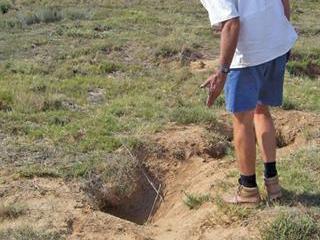Martin Voigt was recently crowned Overall Winner of the 2009 Philadelphia Holstein Herd competition. He won the first lactation group with daughters of French bulls Lounge, Zarik and Iron Boss, the second lactation group with daughters of Iron Boss, Tailor and Farmer, and took third prize for the third lactation group. He also won the Junior Champion Cow category with his cow 6214, a Lounge daughter.
Martin ascribes his success to a simple philosophy: “Don’t breed for milk production. Rather focus on good dairy characteristics – strong legs and hooves for walking and a well-sprung rib shape, so there’s space for all the internal organs to work optimally. A shallow udder with good teat positioning that sits high is also important. Production will follow suit.”
Martin has been farming on Drie Susters between Durbanville and Malmesbury in the Western Cape for 21 years. He milks 480 Holsteins three times a day, averaging 36â„“/cow, with butterfat content of 3,5%, while the industry norm is 1,2%, and a protein content of 3,15%. He’d like to improve these figures to 40â„“/day. “In 2000 we were satisfied with 25â„“/day, so I’m amazed at the progress we have made. It gives me confidence that we’ll be able to improve in future,” he says.
He’d like to expand his herd to 1 000 cows, but that would mean upgrading, among other things, his 24-point milking parlour, at the expense of R10 million. He therefore focuses on first improving the existing herd’s production figures.Cows on Drie Susters used to live outdoors. “But we have wet winters, causing mastitis problems, and in summer heat stress lowers feed conversion and production,” he recalls. Housing structures for 600 cows were erected in 2006. “Mastitis is now within acceptable limits, and we can manage heat stress with overhead sprinklers.”
European bulls
Martin used local bulls until 2006, as overseas breeding material was up to 40% more expensive. But in 2006, on the advice of his breeding consultant, he took the plunge with more expensive bulls from Europe. The additional cost is reflected in increased production. He now only uses bulls from the European Holstein breeding programme. “My gut feeling about choosing European bulls over US bulls was confirmed in 1998 when I did a tour of European dairy countries,” he says.
In the US, farmers form syndicates that invest in a specific bull, and go all out to promote it and sell more semen. The focus is on getting return on investment, not long-term breeding strategies.
In Europe, farmers belong to cooperatives. Their bull-testing programmes don’t let individual farmers choose which test bulls they use. This means only bulls with the potential to perform long-term are entered into their breeding programme.
The European test programme does annual baseline adjustments, unlike other programmes that only revise data every five to 10 years. Milk production per cow increases continuously, so the base from which to evaluate a bull’s performance needs to be adjusted accordingly.
With infrequent revision, bulls appear to perform better on paper, but Martin explains that isn’t necessarily the case in practice. Since 2006, he has only used bulls from the European breeding programme, and he has a long standing relationship with his breeding consultant. “I believe in walking the road with one person, who can get to know my herd intimately,” he says. “I can develop a trust relationship with that person.”
Selecting a bull
Martin always uses AI, and has never had a “stand-in” bull. If a cow doesn’t take with AI, he prefers to cull it. He feels breeding bulls shouldn’t be evaluated on lineage alone. A bull might have a mother with weak dairy characteristics, which will manifest in your herd over time. He only uses bulls with a 90% accurate rating in the bull guide. “Don’t use a bull that has a good profile, but hasn’t proven itself with daughters with consistent strong dairy characteristics,” he advises.
He feels strongly about corrective mating, as propagated by some semen companies. “Using a computer programme to manage your breeding programme has limitations, and I don’t believe a computer can understand the finer points of biology that come into play in the long term,” he says. “Companies can also manipulate these programmes to promote specific bulls.
“Rather choose a bull and use it on 500 cows before making any changes. Once you have around 80 daughters, you’ll have a clearer idea of its impact on your herd. If you’re using multiple bulls at once, you’ll never get an idea of who’s doing what for your herd.” This approach also makes it easier to choose replacements if a bull doesn’t deliver.
Martin aims to breed cows of medium build with a high feed conversion rate and longevity. Currently he’s realising feed conversion of 1kg drymatter into 1,54â„“ of milk. Longevity is currently 3,2 lactations, and his goal is four.Martin is optimistic, and says the dairy industry will always be cyclical. “A farmer should make provision for the bad times during the good times,” he says.Contact Martin Voigt on 021 971 1793. |fw









